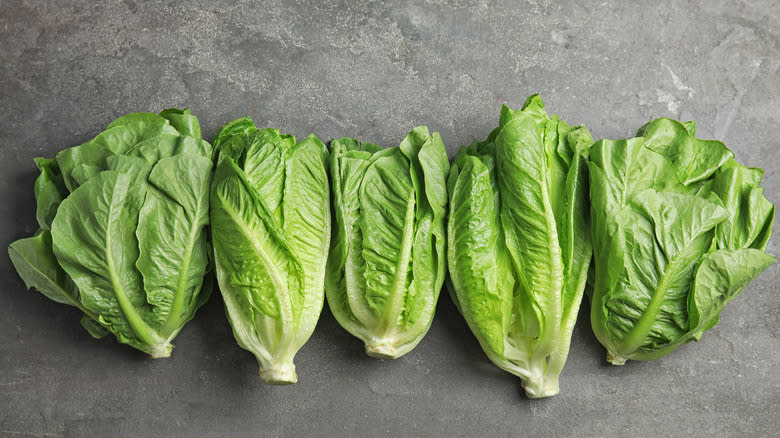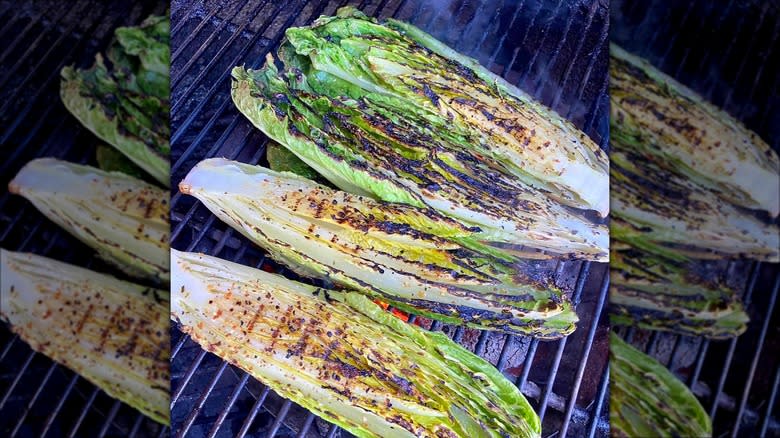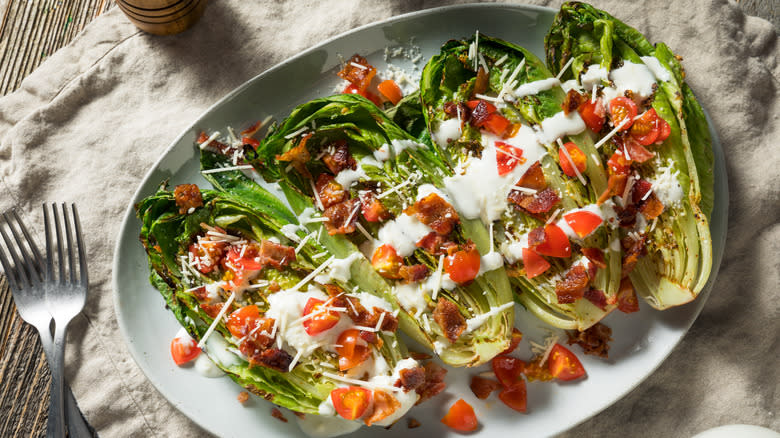Why Romaine Is The Absolute Best Type Of Lettuce For Charring

As the temperature rises, so does the desire to enjoy dinner al fresco. Breaking out the grill is an inevitable sign of delicious summer meals ahead, but while you're at it grilling burgers, meats, and corn on the cob, don't count out charring lettuce as well. While crisp, crunchy lettuce is essential for a fresh salad, the deep undertones of flavor from charring the salad greens are not to be underestimated and can take your grilled meals to new heights.
However, when it comes to charring lettuce on the grill or under the broiler, not just any bunch will do. You know romaine lettuce as the crunchy and refreshing lettuce famously used for Caesar salads, but it's also the best choice when it comes to grilling or broiling your greens. That's because Romaine lettuce is sturdy enough to take on the heat.
Other types of lettuce will wither away when grilled or broiled, but crispy, hearty romaine leaves will gently wilt and sweeten while the base stays intact, so the char can lend an earthy, smoky flavor. Whether romaine is a food you didn't know you could grill, or you're not entirely sold on the idea of cooked lettuce, serve charred romaine appropriately, and you'll have a deliciously simple yet complexly savory bite for your next cookout.
Read more: 12 Vegetables And Fruits That Used To Look Very Different
What To Know Before Charring Your Romaine Lettuce

Charring romaine can be quick and easy, but there are a few things to keep in mind before you get grilling or broiling. The way you cut your romaine matters. You'll want to give your head of romaine a clean slice down the middle lengthwise. This vertical cut keeps the heart intact, ensuring the lettuce leaves stay together and don't separate during charring.
Romaine lettuce has layers of crisp leaves, so you want to make sure the smokiness from the grill reaches all the crevices. The best way to achieve this is by using halved romaine hearts instead of whole heads of romaine, and then slathering the cut side of each half in olive oil. Use a brush to coat the entire surface, allowing the oil to drip in all of the romaine's nooks and crannies. This way, if you're planning to use the grilled greens to amp up your salad, each layer of lettuce will end up with some nice charring when you cut it apart.
If you don't have access to a grill, you can still make charred romaine by making use of your oven's broiler. Set your broiler to high, and keep watch as the romaine hearts begin charring. It should only take about two and a half minutes on each side to develop some browning and char at the edges.
Serving Ideas For Charred Romaine Lettuce

Charring romaine unearths the lettuce's deeply sweet yet slightly bitter flavors. But while these elements come to the forefront, there are plenty of ways to upgrade the leaves that highlight and perfectly counter their earthiness. You can choose to simply serve grilled romaine hearts with a Caesar vinaigrette, shaving a sharp Parmigiano Reggiano cheese on top to add a salty, nutty richness. You can even melt the cheese on top to help distribute it through the gaps in the lettuce leaves.
If you want to keep it super simple, don't skip one essential ingredient in this serving scenario: Lemon juice. Acidic, tangy lemon juice is the key to bringing brightness to the lettuce that could otherwise be weighed down by the rich, earthy flavors and slight bitterness from the charring. A sprinkle of salt and a crack of fresh black pepper, along with a squeeze of lemon juice, is enough for grilled romaine to shine as an entree. However, the charred greens pair excellently alongside grilled meats or skewered vegetables. For the best charred lettuce, choose romaine over other varieties and your grilling will be golden.
Read the original article on Daily Meal

